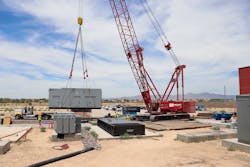Blake Weaver, Data Center Specialist at ProLift Rigging, explores what it takes to win with modular construction in the speed to market race.
Blake Weaver, Data Center Specialist, ProLift Rigging
It’s no surprise that the funkiness of 2020 has helped accelerate many disruptions within the data center market. The sudden and drastic increase in network traffic, especially since March, means that more data centers are needed…quickly. The market is dynamically responding in large part with an emphasis on modular construction. Speed to market remains paramount, and the modular trend presents a host of challenges to key contractors and suppliers.
Modular construction demands a different racing mindset. It’s not simply about speed, rather it also requires agility and extreme coordination. This is starkly evidenced in some of the challenges facing the key suppliers of mission critical equipment (generators, cooling systems, power centers, etc.). In a November 2019 Data Center Dynamics article, Patrick Donovan with Schneider Electric provides helpful insight on some specific risks. He states, “There is also the risk that transportation costs for a large prefabricated data center may be prohibitive, or that accessibility for service personnel may be difficult in cramped conditions, leading to higher operating costs.” In addition to these risks, suppliers must understand and mitigate the parameters of storage, handling, rigging, and final installation, especially when turnkey solutions are expected.
What are some key questions or considerations for suppliers when thinking through the engineering or design phase? Below are a few examples:
- How might the structural design of the skid impact transportation feasibility and cost?
- Will the structural design of the module withstand loading, unloading, storage, installation, etc.?
- How does over dimensional packaging impact storage accessibility and cost?
- Where should rigging points be installed to optimize the most efficient install method?
Overcoming these hurdles upfront will undoubtedly help suppliers and contractors keep pace.
Since modular construction by nature requires deep integrated relationships with other parties, it is critical to choose partners that act like trusted advisors or coaches throughout the engineering and construction process.
A high commitment to discovery and coordination is the secret to performing well in the modular race. A trusted adviser or coach might be utilized to help coordinate the discovery, which would ultimately eliminate a lot of the guesswork and potential pitfalls. What does this look like? In a recent Podium Runner article, Mario Fraioli describes a few elements of a good running coach, which appropriately parallels the data center construction space. He says, “She taught me the value of developing a relationship with your athletes, taking the time to understand them as people first and athletes second, and that coaching is more than just plugging X’s and O’s into a spreadsheet. Coach B was always looking out for the long-term.”
Since modular construction by nature requires deep integrated relationships with other parties, it is critical to choose partners that act like trusted advisors or coaches throughout the engineering and construction process. ProLift is helping several suppliers and contractors in this capacity. A few examples of this engagement include:
- Helping plan and perform modular mock-up exercises, which entails advising on divisible module rigging points, installation sequence, lift plans, etc.
- Recommending efficient module design and optimal shipping dimensions that are within DOT parameters, as well as, physical truck and trailer capabilities.
- Providing turnkey support from loading modules off the production floor to setting at their final location on site across the country. This process is shared with all stakeholders to ensure high level of visibility through our cloud-based reporting platform, which provides critical real-time data, such as:
- Revised production completion dates
- Site needs by dates
- Transit status
- Storage tracking
- Offload and installation status
- Transportation sourcing options
In summary, performing well in the modular race is not an option. Not only is precious market share at stake, but the world is also depending on the rapid expansion of the data center market. A trusted adviser, who is willing to take the time to understand and engage in the unique challenges among integrated parties, is a competitive advantage in the modular race.
Blake Weaver is a Data Center Specialist at ProLift Rigging.


